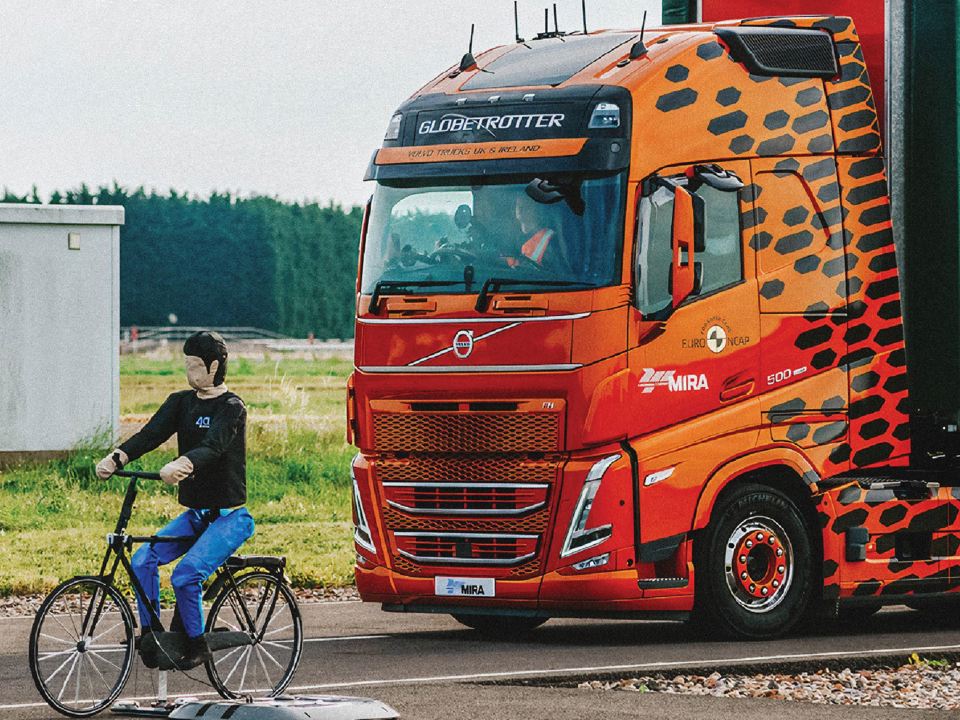Euro NCAP has outlined the elements it is currently considering as part of a future Truck Safe rating and how it intends to evaluate and benchmark truck safety.
The first release of ratings will be announced in November 2024 and will focus on the fitment of crash avoidance technology.
As manufacturers respond to the tests, the requirements will evolve. In 2027, increased active safety requirements around manoeuvring will be required; then in 2030, Euro NCAP will commence the crash testing of trucks to encourage better passive safety protection. The vehicles will be tested by sector and will focus on city delivery; highway distribution; long haul; and tipper and refuse trucks.
Matthew Avery, director of Strategy Development at Euro NCAP, said: "Euro NCAP’s new Truck Safe rating scheme will be a first for the sector and will enable all stakeholders in the freight industry to identify and assess the safety level of trucks.
"Not only will this deliver enhanced safety for drivers but also create opportunities for those operators that invest in the safest vehicle making the scheme attractive to insurers and freight shippers alike. In creating a market for safety Euro NCAP will allow encourage manufacturers and suppliers to innovate further increasing the safety benefits of the scheme as the ratings evolve.
"Cities and regional authorities will be able to clearly identify the best vehicles for their roads and incentivise adoption; and companies will be able to easily determine the safest vehicle suitable for the role. The new rating builds on Euro NCAP’s ’s successful Light Commercial Van safety scheme – enhancing Euro NCAP’s ’s messaging for fleets and business: Safer Vehicles = Safer Profits."
All protocols and requirements are being developed in collaboration with Euro NCAP members, test facilities and reviewed with manufacturers.
The following systems are being assessed by Euro NCAP:
Intelligent Speed Adaptation (ISA)
Speed is well known to be a contributing factor in many crashes and whilst trucks have top speed limiters for Highways, they do not prevent speeding on other road types.
ISA can automatically read the speed limit and control the speed of the vehicle meaning the driver can focus on the road and not worry about breaking the law. The system uses cameras and GPS mapping to identify the correct limit and warn the driver if they exceed the limit or even prevent the truck from speeding in the first place. These systems can even read the variable speed limits that we see on our Motorways and Autobahns.
Autonomous Emergency Braking (AEB)
AEB has been fitted to trucks for some years and uses radars fitted at the front sometimes using a camera to help identify the collision object.
However, its performance has not been as high as passenger cars where we see a 40% reduction in front into rear crashes.
Euro NCAP believes these systems could be better and help reduce the 9% of car occupant fatalities and 17% of truck occupant fatalities that occur when a truck runs into the back of another vehicle.
AEB Vulnerable Road Users (AEB VRU)
Euro NCAP has tested AEB for pedestrians since 2016, and all new cars will react and brake for crossing pedestrians – adults and children.
However, only one truck has a system in production. These systems often fuse camera, radar data, and warn the driver or even automatically brake.
Euro NCAP wants all manufacturers to fit AEB systems that can not only detect crossing pedestrians but also cyclists, and even eScooter riders.
It is thought that systems like these could prevent a third of all HGV to pedestrian crashes.
Lane Support Systems (LSS)
Trucks running off the road or veering into the opposite lane account for 40% of fatalities from single vehicle crashes and 4% of those from head on collisions.
Lane Support Systems can prevent these crashes and whilst a warning is obligatory in new vehicles, Euro NCAP will test for systems that can prevent the vehicle moving out of lane by actively steering the vehicle.
Lane support systems use cameras to identify white lines and road edges where there are no white lines helping to reduce fatigue and making our roads safer.
Nearside Turn AEB and Move Off Prevention
There are certain crashes where the basic design of trucks is a contributory factor– the cabs are high off the road.
Whist they offer a commanding driving position to help drivers manoeuvre the vehicle they make it difficult for drivers to see pedestrians and cyclists near to the truck.
Collisions like this represent around 6% of all fatalities and can be divided into two types: those where a truck turns to the nearside across the path of a cyclist; where a pedestrian is hit when the truck moves off from rest.
Truck makers are responding to this by increasing what is known as direct vision – lower cabs, bigger windows, and low-level windows in the passenger door.
Euro NCAP will be testing systems that can identify an imminent collision with cyclist or pedestrian and intervene more quickly than an attentive driver would do. These systems use sensors on the front and side of the vehicle actively scanning these blind spots making Europe’s city streets safer.
Camera Monitor Systems (eMirrors)
The fitment of electronic mirrors (eMirrors) effectively replaces an actual mirror with a tiny camera and present a large field of view with less image distortion than equivalent mirrors.
In some cases, they can even adapt the view to the driving situation (e.g. giving a wider angle when an articulated vehicle is turning so the driver can still see the rear of the trailer).
These systems can also be especially useful when integrated with blind spot information and warning systems, to focus the attention of the driver on the cab location where the potential hazard can be seen, identified and avoided.




















Login to comment
Comments
No comments have been made yet.